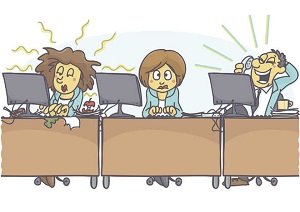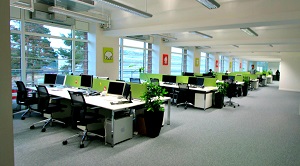Open Offices: Friend or Foe?
By Sydney Kopelic

It’s my first day at my new job. I am so excited to get to the office, as I have been told throughout my entire interview process about the amazing newly renovated floor I would be working on, complete with standing desks, large open spaces, and even a communal café with couches and large TVs. It sounded so cool! However, once I arrive at the office and begin the floor tour with the rest of the new hires, the stars in my eyes slowly start to dissipate. In this grand open space, there is no real space to call my own. I am told to find an open seat wherever, and given a headset to block out the noise of cell phone rings, printers, and heated conversations between workers across the floor. Because the desk I choose will likely be occupied by someone else the next day, I am also given a locker to house my personal items overnight, like my laptop and onboarding documents. As I try to settle into work at “my” desk, I can’t help but feel slightly disappointed. For weeks, I have been looking forward to this career advancement opportunity, and yet I feel like I was transported back to high school; at a bland desk, with a locker, trying to focus under my drugstore headphones.
It may be apparent that I was not too fond of my open-office working experience. In fact, there were mixed emotions about this floor design throughout the business; some positive, some negative. This disparity sparked my interest in the topic of the open office movement, which has been growing more and more popular ever since tech giants like Google, Apple and Facebook began embracing the open layout in the early 2000s (Rampton, 2018). An open office is a workspace in which multiple employees work in close proximity to one another with small, if any, barriers in-between. Some are more segregated, with designated areas for different departments, while others are total free-for-alls, where workers from different levels and lines of business work side-by-side in unassigned seats. The open design is said to foster communication, increase collaboration, and break down hierarchies, helping to build a sense of community within an organization (Clay, 2018; Sander, 2018). Given that the amount of time employees spend on collaborative activities has increased by at least 50% in the past 20 years, it is justifiable that many companies have renovated their workspaces to accommodate for this type of work (Sander, 2018). Unfortunately, many companies may have jumped on this bandwagon without first validating the claims made by open floor-plan advocates. While it is true that open offices do have their benefits, many claims originally made by open office advocates have little to no scientific evidence to support them. In fact, many of those claims have been completely discredited by research. This article explores the actual pros and cons of open floor plan offices as suggested by recent research, as well as offers suggestions for what organizations should consider before jumping on the open office bandwagon.

Saving Money
The explosive popularity of open office plans is not completely unwarranted. While they may be flawed, they do offer one large benefit: cost-effectiveness (Diaz, 2018). An open office space can fit more employees into a smaller space, decreasing the total amount of office space needed. Due to the increasing adoption of open office plans, the average space allotted to individual employees has decreased from 225 to 151 square feet per worker between 2010-
2017 (Peterson, 2015; Schwab 2019). Costs also decrease for actual construction of office space, as less walls are needed since individual offices are eliminated. The open space also helps save on utility costs. Greater window access increases the amount of natural light let into the space, as well as gently heats the space with increased sun exposure, decreasing heating costs in cold climates. Lighting and temperature settings can also be controlled for an entire floor. In fact, open spaces allow for better air flow, so there is less of a need for fans and other cooling systems to maintain constant temperatures systems (Partners in Building, 2017).
Decreasing Communication
In addition to helping cut-costs, open office plans have also been found to encourage interaction between teams (Schwab, 2019). According to Schwab (2019), this is useful when a company is trying to create new products, such as designing new fashions or generating ideas for new technology. Unfortunately, they are not useful for encouraging interaction within teams, which is necessary for execution-based work, like writing code or sorting through a data set. This is in slight contrast to the belief that open offices help to increase communication between workers. In fact, employees in open plan offices spend 73% less time in face-to-face interactions and spend 67% more time communicating via email than those with individual office spaces (Sander, 2018).
Increasing Distractions
Another major problem with open office spaces is that they hinder one’s ability to avoid distractions, such as interruptions from coworkers and noises from ongoing conversations or phone calls. Many employees in my office would wear headphones in attempt to mask the noises around them and focus on their work. This is a common trend in open work spaces (Tierney, 2012). When distractions make it hard for someone to focus, they are forced to use additional cognitive and emotional resources to complete their work. This causes stress levels to rise and errors to occur, which decreases performance quality and quantity. If fact, workers in open office spaces lose as much as 86 minutes per day due to noise distractions (Stout, 2015). Again, what if the company’s goal is to create new products? The increased noise and interruptions may still hinder performance. According to Stout (2015), 65% of creative people need quiet to do their best work. When those employees can’t concentrate on their work, their desire to interact and collaborate with others is reduced (Sander, 2018). So, while the aim of the open office may be to increase collaboration and communication, it may just do the opposite.
Dampening Employee Morale
The final and more disturbing issue with open office spaces is that they can drain employee morale in multiple ways. For starters, they can make employees feel disposable. An office or designated work space with an employee’s name on it is a visible and physical representation of their place within an organization. Unassigned seating can make employees feel they are unimportant and easily replaceable (Clay, 2018). Unassigned seating also prevents workers from personalizing their spaces with things such as personal pictures or memorabilia, making their workspace feel cold and uninviting (Clay, 2018). It is not just the workstation itself that contributes to employee morale loss. When subordinates and managers are working closely, perception of supervisory support actually decreases (Morrison & Macky, 2017). One would assume that the increased accessibility to supervisors in an open office would lead to more contact and communication with subordinates, and thus increase perceptions of support. However, it turns out that when supervisors and subordinates work in close proximity and interact more often, the quality of their interactions decreases and becomes more casual. In contrast, when they do not see each other often, the time supervisors and subordinates do spend together in purposeful meetings is perceived to be higher in quality (Morrison & Macky, 2017).
The final nail in the coffin of employee morale is brought upon by the aforementioned increase in noise and decrease in sound privacy brought on by open office spaces. When people have trouble focusing, they also become less satisfied than when they are in more traditional office spaces (Clay, 2018). In fact, lack of sound privacy has been shown to be one of the biggest draining factors on employee morale (Calisi & Stout, 2015). These negative consequences of open office spaces should not be overlooked. While not every employee may dislike this approach, it appears that most do. As of last year, there were 62 percent more sickness-related absences in organizations with open office spaces than those who provided employees with their own offices (Clay, 2018). It may be true that these absences were indeed sickness related, and caused by expedited spread of germs in the open space. However, another possible explanation is that employees simply wanted to work in the quiet privacy of their own space, and thus chose to stay home for a much-needed retreat from their bustling office from time to time.
So…Now What?
Open offices are not all bad. However, before an organization starts tearing down office walls, they should think of a custom approach that would best suit their organizational mission and culture. In my opinion, best practice would be to maintain a more traditional office design, with assigned work areas for specific employees or work teams, but cater to lovers of open space by setting aside a few large areas, such as the kitchen or large conference rooms, for communal work. This solution would allow space for collaboration when needed, but available assigned spaces would make workers feel recognized and significant. In the event that a more open office space is adopted, companies should still have some private areas, such as conference rooms or single open offices, for employees to reserve when they need to fully concentrate. It is important to recognize that employees may have different needs throughout their day depending on the nature of their work. They may need to focus on a specific task for one hour, and brainstorm with a work team the next.
In order for employees to work efficiently, employers need to accommodate for these multiple levels of social interaction. In other words, accommodate for the type of work you are asking employees to do in order to get the most out of them. Additionally, open floor plans should not be a replacement for formal supervisory feedback or formal team meetings. Employees need that structure to feel that the protocols are still in place. In fact, as the negative aspects of open office are beginning to surface, some organizations seem to be adopting this more à la carte approach to open office implementation. According to The Wall Street Journal, a privately conducted survey of 138 employers found that by 2021, 52 percent of surveyed companies plan to replace their fully open-plan offices with "first-come, first-served desks, plus additional workspaces with names like huddle rooms and touchdown spaces" (Shellenbarger, 2018). Open office spaces may be the future for certain types of work, but they should not be implemented as an attempt to follow the big names in business, or to “get with the times”. While the communal feel may be beneficial for some types of work, research (and personal experience) suggests that they may not be best suited for everyone.
Author Bio

Sydney Kopelic is a second-year graduate student in the Industrial-Organizational Psychology and Human Resource Management (IOHRM) program. Before her time at Appalachian State, she received a Bachelor's degree in Psychology from the University of Alabama, and became determined to utilize her knowledge of the field to help improve the lives of as many people as possible in the place where they spend the largest chunk of their time; at work. She currently serves as Assistant Director of the Appalachian State HR Science research team, and also acts as the HR Coordinator for Beans 2 Brew, a student run certified non-profit organization based on campus. Outside of Appalachian State, Sydney has worked two summers with Bank of America, one as an Entry Level Development Coordinator for newly hired Global Investment Bankers, and the other as an HR Generalist for the Global Technologies and Operations sector.
References
Clay, B. A. (2018, June 14). Tear Down That Wall and You May Annoy Your Employees. Retrieved from https://www.shrm.org/resourcesandtools/hr-topics/employee-relations/pages/open-office-spaces-annoy-workers.aspx
Diaz, J. (2018, August 18). The real reason your company switched to an open plan office. Retrieved from https://www.fastcompany.com/90220029/the-real-reason-your-company-switched-to-an-open-plan-office
Morrison, R. L., & Macky, K. A. (2017). The demands and resources arising from shared office spaces. Applied ergonomics, 60, 103-115.
Partners in Building. (2017, May 12). Open Floor Plans Are Not Just Trendy; They’re Energy-Efficient. Retrieved from http://partnersinbuilding.com/news/open-floor-plans-are-not-just-trenty-theyre-efficient
Peterson, K. (2015, March 09). Companies are packing workers in like sardines. Retrieved from https://www.cbsnews.com/news/companies-are-packing-workers-in-like-sardines/
Rampton, J. (2018, May 15). Facebook's Utopia, Our Nightmare: Open Offices Are Destroying Productivity. Retrieved from https://www.entrepreneur.com/article/313034
Sander, L. (2018, September 10). A new study should be the final nail for open-plan offices. Retrieved from https://theconversation.com/a-new-study-should-be-the-final-nail-for-open-plan-offices-99756
Schwab, K. (2018, November 29). Yet another way open offices are making you less productive. Retrieved from https://www.fastcompany.com/90273633/yet-another-way-open-offices-are-making-you-less-productive?partner=rss&utm_source=rss&utm_medium=feed&utm_campaign=rss fastcompany&utm_content=rss?cid
Schwab, K. (2019, January 15). Everyone hates open offices. Here's why they still exist. Retrieved from https://www.fastcompany.com/90285582/everyone-hates-open-plan-offices-heres-why-they-still-exist
Shellenbarger, S. (2018, May 15). Don't Get Too Used to Your Own Desk. Retrieved from https://www.wsj.com/articles/dont-get-too-used-to-your-own-desk-1526390258?ns=prod/accounts-wsj
Stout, C. (2015, March 16). Stop Noise from Ruining Your Open Office. Retrieved from https://hbr.org/2015/03/stop-noise-from-ruining-your-open-office
Tierney, J. (2012, May 19). From Cubicles, Cry for Quiet Pierces Office Buzz. Retrieved from https://www.nytimes.com/2012/05/20/science/when-buzz-at-your-cubicle-is-too-loud-for-work.html?pagewanted=all&_r=1
Disclaimer: The views and opinions expressed in this article are those of the author and do not necessarily reflect the official policy or position of the IOHRM program, Departments of Psychology and Management, Colleges of Arts and Sciences and Business, and Appalachian State University.